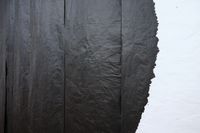Black Circles
2021, Black Circles No 1 – No 5
Work in progress, Tusche auf Chinapapier, Grösse variabel
Black Circle No 1: Tusche auf Chinapapier, 45 cm x ca. 800 cm, 8 Bogen, Gesamtgrösse: 3,6 m x ca. 5 m, Durchmesser Tuschekreis ca. 3 m, 2021
Black Circle No 2: Tusche auf Chinapapier, 45 cm x ca. 800 cm, 6 Bogen, Gesamtgrösse: 2,7 m x ca. 8 m, Durchmesser Tuschekreis ca. 2,2 m, 2021
Im Zentrum der Black Circles stehen schwarze Kreisflächen. Sie markieren manifeste Zentren, die sich durch ihre Charakteristika jedoch selbst in Frage stellen.
Die Tuschekreise erstrecken sich über mehrere, schmale, nebeneinanderliegende Papierbahnen. Jede Papierbahn enthält ein Teilstück der Kreisflächen. Der Kreis als Symbol der Ganzheit und Vollkommenheit ist in den Black Circles somit in Fragmente gegliedert, ist in sich sehr beweglich und nicht statisch ruhend in sich selbst. In seiner Grundform nährt er sich lediglich einer runden Form an, denn die Umsetzung eines perfekten Kreises ist auf den Papiersegmenten und der Tusche gar nicht möglich. Das Scheitern ist Teil dieser Arbeit. Das Scheitern bedingt das Gelingen, denn es geht nicht um das Perfekte, vollendet Ganze, sondern es geht um die Freiheit der Differenz. Das Zulassen und auch Sichtbarmachen von neuen, unerwarteten Möglichkeiten, die das vollendet Ganze schlussendlich vervollständigen, denn sie sind Teil davon. Das Vollkommene und Unvollkommene bedingen einander.
Die Tusche zerfliesst in dem dünnen, strapazierfähigen, opaken Papier. Der Kreisrand zerfliesst, wird ungenau. Zufälliges stellt sich ein. Es entstehen Treppenstufen zwischen den Papierbahnen. Die Kreislinien weiten sich ins Unendlich aus, in dem ihre Ziselierungen an Fraktale erinnern oder ganze Berge und Landschaften entstehen.
Das mit Tusche durchtränkte Papier weist eine veränderte Materialität auf und wirkt wie ein schwerer, zerknitterter Stoff. Durch die Reflexion des Lichtes entsteht ein matter, rötlicher Schimmer. An gewissen Stellen hat sich die Tusche massiv konzentriert. Im trockenen Zustand glänzen diese Bereiche metallisch.
Das Hängen der flexiblen Papierbahnen lässt sich den räumlichen Gegebenheiten anpassen. Der grössere Kreis ist an einer Wand montiert, während der kleinere Kreis mitten im Raum hängt. Seine Rückseite ist von dem bis zum Boden fallenden Papier bedeckt. Von dieser Seite aus kann man die Kreisfläche nur schemenhaft wahrnehmen. Es entsteht ein Objektcharakter. Der grosse Kreis, an der Wand hängend, verbirgt seine zweite Seite vollends. Zwischen den Kreisen entsteht ein Dialog, der sich je nach Betrachtungsstandpunkt verändert.
Geht man am Papier vorbei, bewegt sich dieses im Luftzug, den man erzeugt. Zwischen den Papierbahnen gibt es Spalten, durch die hindurch man die Wand oder den Raum auf der anderen Kreisseite sehen kann. Das Bild des Kreises vollendet sich mit dem Einschluss des architektonischen Umraumes.
Die Kreisflächenmarkieren ein Zentrum mit vielen Bedeutungsebenen, das sich selbst befragt und diese Befragung auf der Rezipientenebene mitten in den Raum stellt. Die Werkinterpretation bleibt schlussendlich jedoch offen.
Black Circles
2021, Black Circles No 1 - No 5
Work in progress, ink on China paper, size variable
Black Circle No 1: Ink on China paper, 45 cm x approx. 800 cm, 8 sheets, total size: 3,6 m x approx. 5 m, diameter ink circle approx. 3 m, 2021
Black Circle No 2: Ink on China paper, 45 cm x approx. 800 cm, 6 sheets, total size: 2.7 m x approx. 8 m, diameter of ink circle approx. 2.2 m, 2021
The central focus of the Black Circles are black circular areas. They indicate manifest centres which, however, by their characteristics raise questions about themselves.
The ink circles extend over several, narrow, adjacent paper webs. Each paper web contains a section of the circular surfaces. The circle as a symbol of unity and perfection is thus divided into fragments, is very mobile in itself and not statically resting in itself. In its basic form, it merely nourishes a round shape, because the realisation of a perfect circle is not at all possible on the paper segments and the ink. Failure is part of this work. Failure conditions success, because it is not about the perfect, complete entity, but about the freedom of difference. Allowing and also making visible new, unexpected possibilities that ultimately complete the perfect whole, because they are part of it. The perfect and the imperfect are mutually dependent.
The ink dissolves in the thin, hard-wearing, opaque paper. The edge of the circle dissolves, becomes imprecise. Randomness appears. Steps are created between the paper webs. The circular lines expand into infinity, in which their chiselings are reminiscent of fractals or entire mountains and landscapes emerge.
The ink-soaked paper shows an altered materiality and appears like a heavy, crumpled fabric. The reflection of the light creates a matt, reddish shimmer. In certain places the ink has concentrated massively. When dry, these areas shine metallically.
The hanging of the flexible paper webs can be adapted to the spatial conditions. The larger circle is mounted on a wall, while the smaller circle hangs in the middle of the room. Its back is covered by the paper falling to the floor. From this side, the surface of the circle can only be perceived dimly. An object character is created. The large circle hanging on the wall completely hides its second side. A dialogue is created between the circles, which changes depending on the point of view.
If you walk close to the paper, it moves in the breeze that you create. Between the paper there are gaps through which one can see the wall or the room on the other side of the circle. The image of the circle is completed with the inclusion of the surrounding architectural space.
The circular surfaces mark a centre with many levels of meaning that questions itself and places this questioning in the middle of the space on the recipient level. In the end, however, the interpretation of the work remains open.








